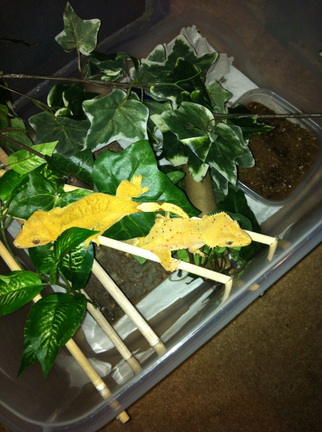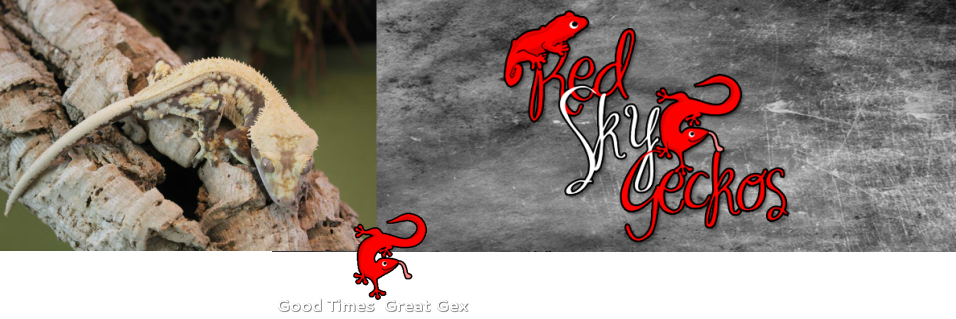 This is a sterlite 50 qt modified into a love nest for 2. It is large enough for 3.
This is a sterlite 50 qt modified into a love nest for 2. It is large enough for 3. Breeders have different opinions about pairing crested geckos. Some leave them in 1:3 groups, others 1:2 and 1:1 and still others only leave the male in long enough to do his job and then separate them. My personal choice (and I am running 1.1 and 1.2's right now) is to have a 1.1. Tracking the genetics is important to me and I like to know who mom is. But with a 1.2 I like the fact that it saves space, also I think that it gives the girls some relief from the male. I leave in older males because they usually don't lose weight or cause their partners to either, but remove the younger males because they are more likely to get into a prolapse situation, drive the girls crazy, and keep them from laying on a regular schedule by wanting to mate every time the girl heads for the nest box. But if the girls get along then I leave them together. I have certain girls who can only live with a male and certain girls who can't live with anyone, so that makes a difference too.
Bottom line: You can breed in any of those combinations. But you have to make sure you have girls who won't fight each other, plenty of space, food and hides for each of the geckos, plenty of nest boxes. Overcrowding can cause excessive stress and fighting and will lead to illness. Then you need to be willing to live with "mystery moms" or else watch daily to see who is in the nest box. You particularly need to keep an eye the health of everyone in the box, the male to make sure he isn't losing too much weight, the females for the same reason, both to make sure that neither one is getting beat up too much (some wear and tear is normal, you might see missing crests particularly, but you shouldn't see bleeding cresties), and watch the females for egg binding and the males for prolapse. Group size depends on the personalities of the cresties involved and what you need in order to meet your space and breeding goals. Just remember: the health of the geckos should always come first.
Bottom line: You can breed in any of those combinations. But you have to make sure you have girls who won't fight each other, plenty of space, food and hides for each of the geckos, plenty of nest boxes. Overcrowding can cause excessive stress and fighting and will lead to illness. Then you need to be willing to live with "mystery moms" or else watch daily to see who is in the nest box. You particularly need to keep an eye the health of everyone in the box, the male to make sure he isn't losing too much weight, the females for the same reason, both to make sure that neither one is getting beat up too much (some wear and tear is normal, you might see missing crests particularly, but you shouldn't see bleeding cresties), and watch the females for egg binding and the males for prolapse. Group size depends on the personalities of the cresties involved and what you need in order to meet your space and breeding goals. Just remember: the health of the geckos should always come first.

 RSS Feed
RSS Feed